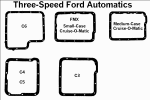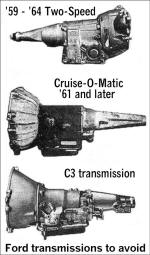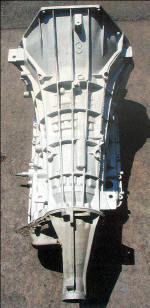|


|

|
|
|
Automatic Transmission Identification Guide
Reprinted from Car Craft 12-02 - Article and photos by Marko Radielovic |
|
|
 |
|
This
article will take a good, hard look at Ford's offerings on the
slush-box front. Seeing as we don't know a heck of a lot about Ford
automatics, we abducted a variety of transmission experts and
interrogated them for the following information. We found that
like GM, Ford also made a number of trannies capable of
fulfilling the needs of the weekend warrior, class racer, heavy
hauler, and Sunday driver. Follow along as we take an in-depth
look at the two-speeds, three-speeds, and the overdrive units. |
|
Two Speeds |
|
Ford offered a "Fordomatic" two-speed between 1959 and 1964 in
six-cylinder applications exclusively (mainly in Falcons,
Comets, and so on). They are easily identified by their
one-piece aluminum case. Unlike GM's Powerglide, they offer no
performance advantages, so forget 'em. |
|
Three Speeds |
|
Ford's various three-speed automatic transmissions came in a
number of applications and a variety of types. The lightest duty
of the three-speed automatic transmissions, the C3, and the
oddball "Cruise-O-Matic" series probably won't be of any
interest to many car crafters. From a V-8 performance
standpoint, there are really only two transmissions to consider
- the C4 and the C6.
The C4
Introduced in 1964, the C4 was Ford's first light-duty
three-speed automatic transmission. It was used behind
four-cylinders, six-cylinders and small V-8s by all Ford
divisions (Ford, Lincoln and Mercury). An interesting feature of
the C4 is its bolt-on bellhousing, which allows it to be easily
adapted to a variety of engine applications. There are two major
C4 case variations with respect to dipstick location: Those with
the dipstick in the case were primarily used in passenger cars,
while those with the dipstick entering directly into the trans
pan were used mainly in trucks, vans and some fullsize cars. On
transmissions with the dipstick in the pan, the bolt-on
bellhousing was also make larger to accommodate a 12-inch torque
converter (the smaller-cased units housed an 11-inch torque
converter). Internally, both versions of the C4 are the same. A
lockup version called the C5 was introduced in 1982 and
continued in use until production ended in 1986. The C5 used a
lockup converter and different valvebody programming, but it was
otherwise similar to other C4 transmissions. C4s were original
equipment behind 260, 289, 302, and 351W V-8s.
Harvey Baker of Performance Automatic Transmissions, makers of
some of the toughest C4s available, says the company prefers the
C4 over other Ford offerings because they are light and
efficient, ranking along with the GM Powerglide and the Chrysler
904 as the least-power-robbing automatics. If there is a weak
point, Baker says, the stock planetary is the component most apt
to fail on a C4. To address this, Performance Automatic builds a
rollerized planetary system (see Fig. 4), which is used in it's
"Super Comp" series of race-ready C4s rated for engines
producing up to 1,200 hp and 800 lb-ft of torque. Super Comp
transmissions feature standard gear spacing (see chart below), a
hardened 26-spline input shaft, the rollerized planetary system,
six-gear pinion, six-clutch drum, and a lifetime warranty.
Performance Automatic claims to have yet to experience breakage
with one of its Super Comp C4s, and the company is so confident
in its strength that it recommends this unit over even a
beefed-up C6.
|

Fig. 01 - Fords automatic transmission
offerings

Fig. 02 - 3-spd ID

Fig. 03 - The Ford transmissions to avoid

Fig. 04 - Rollerized C4 planetary system from
Performance Automatic Transmissions. |
|
The C6
The C6 is to the C4 what the GM Turbo 400 is to the Turbo 350.
Introduced in 1966 and produced until 1989, the heavy-duty C6
was used behind engines ranging from the 351W to the 7.3 Diesel.
Before the advent of race-prepped C4s, the C6 was the auto trans
of choice in performance/race applications. One-piece-case C6s
came in three different bellhousing patterns to accommodate the
three different series engines offered by Ford:
-
small-block
(260, 289, 302, 351W, and 351C)
-
FE-series
big-block (332 to 428)
-
335-series
(429 and 460, plus the 351M and 400, which shared the same
bellhousing pattern
|
|
Three different extension housings (tailshafts) were offered:
the Lincoln version at 17.4 inches long; the truck housing at 7
inches long; and, most commonly, the 14-inch length used in
passenger-car applications.
According to Pro-Formance's Sean Wiley, the C6 really has no
basic weaknesses, and it can withstand obscene amounts of power
in stock form. A good intermediate lever and servo, and a
later-model four-clutch drum modified to accept five clutches
are pretty much all that's needed to fortify the already beefy
C6. Nevertheless, Wiley only recommends their use behind very
powerful big-blocks where the power required to drive the
transmission is less significant. Mike Stewart of Mike's
Transmissions considers the C6 to be ideal for tow vehicles
where the owner isn't concerned with squeezing out precious
tenths of a second, as the internals are so heavy that they eat
inordinate amounts of power.
ATI's Chris Esterly concurs with Stewart, informing us that ATI
rarely builds C6s for performance applications but does so
occasionally for tow vehicles or restorations of musclecars
originally equipped with the C6. With today's crop of small,
high-horsepower motors, the heavy rotating mass of of the C6
simply kills power. Packaging is also difficult, as the massive
C6 doesn't fit easily into many cars.
|

Fig. 05 - Here are the three V-8 bolt
patterns offered on Ford automatic transmissions. |
|
The
Cruise-O-Matic
Introduced in 1951, the Cruise-O-Matic series of three-speed
automatics (which includes the FMX) was used in Ford, Lincoln
and Mercury passenger cars until 1979, and in light trucks from
1968 through 1979. They came in three configurations:
-
the small
case (from 1951 to 1966)
-
the medium
case (from 1955 to 1968), and
-
the FMX
(from 1967 to 1979)
The Cruise-O-Matic transmissions are easily identified by their
design, which incorporates a cast-iron main case (unlike all
other Ford three-speed automatic offerings) with separate
aluminum bellhousings and extension housings bolted to it. The
Cruise-O-Matics should be avoided in performance applications as
very little is available in the way of aftermarket performance
parts other than shift kits. The Cruise-O-Matics were also
offered with all three bolt-common V8-pattern bellhousings.
|
|
|
The AOD |
|
Ford's automatic overdrive (AOD) for rear-wheel-drive
applications was the first of it's kind offered by an American
automaker back in 1980. Featuring mechanical lockup, it was
available behind everything from the 3.8L V-6 through Ford's
Windsor-style V-8s (the 5.0L and 5.8L). The later automatic
overdrive electric (AODE) incorporated computer control.
|

Fig. 05 - 4-spd automatic overdrive ID |
|
According to Mike Stewart of Mike's Transmissions, one of the
most common problems with the AOD is its tendency to burn up the
overdrive band. Mike's Transmissions offers a variety of parts
to bolster the capabilities of the AOD, including an "A+" servo
with grater capacity than stock and a hardened 4340 chromoly
input shaft to replace the notoriously weak lockup input shaft.
Mike's Transmissions also retrofits the larger and stronger
drum/band assembly from the newer AODE to non-electric
AODs. Stewart considers a well-prepped AOD to be capable of
withstanding 700 to 800 hp comfortably, making it safe for use
in street applications less aggressive than all-out race cars. |
|
Canada's Lentech Automatics has a reputation for building the
world's toughest AODs. When asked about the weakest link
in the AOD, Lentech's Chris Nugteren quickly points to an
inherent problem with the power flow through the transmission.
The AOD incorporates a somewhat rudimentary overdrive design
featuring two input shafts. The inner shaft, which is driven
directly from the front cover of the torque converter bolted to
the flywheel, provides direct drive in Third gear and bypasses
the hydraulically driven components of the torque converter
entirely; the hollow outer shaft is driven hydraulically by the
converter and drives First, Second, and Reverse gears. This is
commonly referred to as a split torque path, and it allows 40
percent of the engine's torque to be transmitted via fluid
coupling (through the torque converter) and 60 percent to be
transmitted mechanically while the transmission is in Third
gear. In Fourth gear, 100 percent of the torque is transmitted
mechanically - similar to the direct-drive of a
manual trans.
When building an AOD transmission for a mild street/strip
applications, Lentech first substitutes a nonlockup-style torque
converter, which allows hydraulic damping to reduce the shock
transmitted to the inner shaft compared to a lockup converter.
Another benefit of the nonlockup converter is that Third gear
now receives torque multiplications from the converter rather
than being driven directly by the crankshaft as with a manual
transmission. The result is more potential speed and smoother
operation without the lockup feature. Lentech offers hardened
inner and outer input shafts in the standard spline count.
Another major component of the AOD that needs to be addressed in
a performance applications is the valvebody, which, in
Nugteren's words, "has a shift pattern that sucks." The AOD was
introduced at a time when Ford's automatic-equipped cars rolled
off the assembly line with only three-position column detents.
Rather than design a new column, Ford (during it's "Better
Ideas" days) opted to provide only three shift positions for the
new transmission: First, Drive, and Overdrive, bypassing Second
gear entirely in a manual-shift situation. Mustang owners
quickly learned that if they upshifted from First to Third
(Drive), then quickly downshifted back to First before the trans
made the shift into Third, the trans would hold Second gear
until the driver manually upshifted to Third.
While this technique will work for a while, the overdrive band
and direct clutch will prematurely wear out. Lentech changes the
shift pattern by making a specific gate for Second gear and
combining Overdrive with Drive. Overdrive is controlled with an
electric solenoid in the valvebody (like most overdrive
transmissions).
|
|
Lentech covers mild, but what about wild? The company starts by
replacing the two-piece input shaft with a one-piece nonlockup
4340 chromoly unit (see photo) offered in two states. Stage One
shafts feature a standard spline count, while State Two
one-piece input shafts are offered in larger diameters and
feature higher spline counts. They also offer a matching direct
drum and torque converter. |

Fig. 04 - Ford's AOD comes equipped with a
two-piece input shaft (left) but Lentech Automatics
offers a one-piece 4340 chromoly replacement to
handle brutal horsepower. |
|
Next, the valvebody is replaced with a Lentech unit that applies
two clutch packs to Third gear. Normally only the direct-drive
clutch pack would be used, but the reverse clutch pack is added
to the function, spreading the load over two sets of splines and
friction elements (drums), and allowing it to hold huge
horsepower. It's this single development that has made Lentech's
ultimate AOD transmissions virtually bulletproof. They further
modify the transmission by removing the Fourth (Overdrive)
gear and replacing many of the components with lightweight
pieces. In applications where a "loose" or high-stall converter
is used, Lentech maintains the lockup function of the converter,
enabling it to eliminate the slippage that plagues high-stall
converters. On of its race units is in a Mustang running 8.20s
at 165 mph with no breakage in a full season's use. We would say
that it works!
The AODE is essentially an electronically controlled AOD
transmission, sharing most of its internal parts except for the
input shaft, which has its lockup function controlled
electronically by a computer. As mentioned above, the drum/band
assembly is slightly larger and made of stamped steel (unlike
the cast-iron drum used in the standard AOD), and it is
interchangeable with its counterpart. One advantage enjoyed by
the AODE is that the shift functions and characteristics of the
transmission can be programmed for greater versatility, but this
creates its own unique set of problems.
Ford programmed the AODE to provide seamless transitions between
gears, accomplishing this with a pressure-control solenoid (PCS)
that manipulates the line pressure in the transmission to soften
shifts. Ford also attained seamless shifting by slipping the
converter clutch, which cycles the converter in and out of
lockup. Unfortunately, this prematurely wears out the clutch
materials, which can send debris through the system. Lentech
insists that the first thing to do with an AODE is to add a
performance computer chip that corrects the pulse width of the
PCS and eliminates the multiple personality of the lockup
feature. |
|
|
Other Overdrives |
|
The 4R70W is a wide-ratio version of the AODE featuring a 2.84:1
First-gear-ratio. The E4OD (later renamed 4R100) is still used
in extreme-duty truck applications. It's basically a C6 with an
add-on overdrive unit, making it so massive it's really not
suited for anything other than a truck chassis. But before you
dismiss the E4OD trans as being for tow rigs only, consider it's
the trans used on Ford's Lightning trucks. While not the most
efficient trans, it's capable of absorbing an inordinate amount
of abuse, and its warranty is second to none in the Ford Motor
Company transmission lineup. Lentech also modifies these for tow
and race duty in a similar manner to the AOD. Early E4ODs are
retrofitted with the later 4R100 steel overdrive planetary and
ball-bearing center support, extra clutches are added, the valvebodies are reprogrammed, and an aftermarket torque
converter is usually installed. Lentech is also in the process
of developing a transbrake for use in Lightning trucks in
racing.
Barely worth mentioning is the A4LD trans and the five-speed
derivatives, the 5R55N and 5R55W. These transmission were
introduced in 1985 and used exclusively behind four- and
six-cylinder engines. They are currently still in use by Ford,
based on the C3 three-speed automatic. |

Fig. - The E4OD is Ford's heaviest duty overdrive
automatic transmission. |
Ford Automatic Transmission Guide
This list is not conclusive or absolute, but provides
general guidelines with respect to power ratings. |
|
Trans |
Years |
Case Type |
Trans Usage * |
Vacuum
Modulator
Location |
Kickdown
Cable |
Small-
Block |
FE |
335 |
Stock |
Modified |
|
C3 |
'74-'87 |
- |
- |
- |
D |
D |
right center |
rod |
|
C4 |
'64-'86 |
X |
- |
- |
D |
B |
right rear |
rod |
|
C6 |
'66-'89 |
X |
X |
X |
A |
A |
right rear |
rod |
|
Cruise-O-Matic |
'51-'79 |
X |
X |
X |
C |
C |
right rear |
rod |
|
AOD/AODE |
'80-up |
X |
- |
- |
C |
B |
none |
rod or cable/electric |
|
E4OD/R4100 |
'89-up |
X |
- |
X |
A |
A |
none |
electric |
|
*
Ratings: A=High torque, heavy car; B=High torque, light car;
C=Low torque, heavy car; D=Low torque, light car |
|
Gear Ratios of Popular Ford Automatic Transmissions |
|
Trans |
1st |
2nd |
3rd |
4th |
|
C4 |
2.46 |
1.46 |
1.00 |
- |
|
C5 |
2.46 |
1.46 |
1.00 |
- |
|
C6 |
2.46 |
1.46 |
1.00 |
- |
|
AOD |
2.40 |
1.47 |
1.00 |
0.67 |
|
AODE |
2.40 |
1.47 |
1.00 |
0.67 |
|
4R70W |
2.84 |
1.55 |
1.00 |
0.70 |
|
E4OD/4R100 |
2.71 |
1.54 |
1.00 |
0.71 |

|
SOURCES |
-
ATI
PERFORMANCE PRODUCTS - 6747 Whitestone Rd.,
Baltimore, MD 21207 -
800.284.3433
-
DYNAMIC
CONVERTERS / PRO-FORMANCE TRANSMISSION - 122 Sandy Dr., Ste F,
Newark, DE 19713
-
LENTECH
AUTOMATICS - 3487 Joy's Rd.,
Richmond, ON, Canada K0A 2Z0 -
613.838.5390
-
MIKE'S
TRANSMISSION - 42541 N. 6th St. E., Unit 11,
Lancaster, CA 93535 -
661.723.0081
-
PERFORMANCE
AUTOMATIC INC. - 8174 Beechcraft Ave.,
Gaithersburg, MD 20879 -
800.767.8174 -
301.963.8078
|
|
|
 |

Want to link to
this site? Please save this banner to your hard drive to place on your
webpage.
The correct link to use is
http://www.fordification.com
|